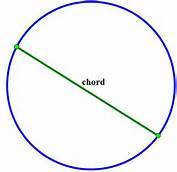Cure for the Common Chord
A unit area circle is partitioned by a chord into two unequal circular segments.
The ratio of the difference in perimeters between the segments to their common chord is 2.
Find the ratio of the minor segment's perimeter to the original unit area circle's perimeter.

Give your answer to 2 decimal places.
The answer is 0.50.
This section requires Javascript.
You are seeing this because something didn't load right. We suggest you, (a) try
refreshing the page, (b) enabling javascript if it is disabled on your browser and,
finally, (c)
loading the
non-javascript version of this page
. We're sorry about the hassle.
2 solutions
How the value of length too is equal to magnitude of the angle subtended by the smaller arc ?
Log in to reply
I think what you are asking is, why the length of the smaller arc is θ .
If we have an arc that subtends an angle of θ at the center of the circle, then the length of the arc is r θ , where r is the radius of the circle. Here, r = 1 .
whrn theta is in radians.
Let
θ
1
and
θ
2
denote the angles of the sectors, such that
- k > 1 is a constant
- θ 1 = k θ 2
Let d denote the length of the chord. Here are the formulas used for the solutions:
- Circumference of the sector : C θ = θ r where r is the radius
- Circumference of the segment: C s = θ + d
- Law of Cosine : c 2 = a 2 + b 2 − 2 a b cos ( α ) where a , b , c are side lengths of the triangle and α is the angle that "faces" the side of length c
Since C 1 + C 2 = 2 π , and the radius of both sectors is 1 , C 1 = θ 1 = k θ 2 and C 2 = θ 2 , which implies that θ 2 ( k + 1 ) θ 2 = 2 π = k + 1 2 π From the given, we can determine the form of the chord length in terms of k : C 1 − C 2 : chord d θ 2 ( k − 1 ) θ 2 ( k − 1 ) d = 2 = 2 = 2 d = 2 θ 2 ( k − 1 ) = k + 1 π ( k − 1 ) For the triangular region of the circle, we can apply the Law of Cosine to determine the value of k and d . For c 2 = a 2 + b 2 − 2 a b cos ( α ) set c = d , a = b = 1 (since the radius of the sector is 1 ) and α = θ 2 . Then, we have d 2 ( k + 1 π ( k − 1 ) ) 2 = a 2 + b 2 − 2 a b cos ( θ 2 ) = 2 − 2 cos ( k + 1 2 π ) Since k > 1 , k ≈ 2 . 7 7 7 2 6 , so d ≈ 1 . 4 7 8 1 7 . Thus, unit circle circumference minor segment circumference = 2 π θ 2 + d ≈ 0 . 5 0
Let θ be the angle subtended by the smaller arc, at the center of the circle. Then the length of the smaller arc is also θ , and the length of the larger arc is 2 π − θ . Let d be length of the chord. (We can compute that d = 2 sin 2 θ , but this fact is not necessary.) From the given condition, d 2 π − 2 θ = 2 , which simplifies to θ + d = π .
Then the ratio of the perimeter of the smaller segment to the perimeter of the circle is 2 π θ + d = 2 π π = 2 1 .